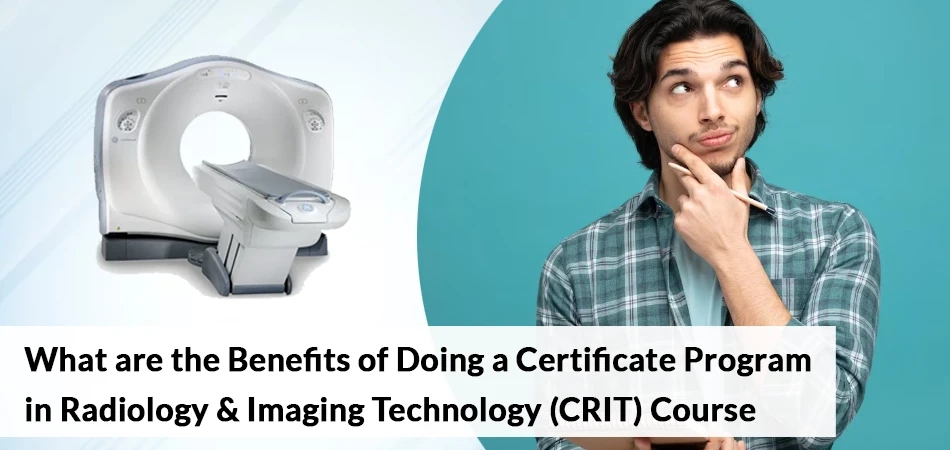
The Radio and Imaging Technology Certificate program is related to the methods and techniques utilised for diagnostic reasons or the branch of medical science that concentrates on examining the full structure and functions of the human body in sections, producing images of its operations. Even though organs and tissues can be imaged after they are removed for medical purposes, this is usually considered a part of pathology rather than medical imaging.
Radiological technology is utilised to generate medical images such as X-rays, MRI scans, and CT scans. Students are ready to assist and ensure accurate execution of X-ray and electrocardiogram tests for patients.
| first semester | second semester |
| Human anatomy, physiology and pathology | Radiation Physics-II |
| Radiation Physics-I | Clinical radiography- I |
| Radiography- I | Clinical radiography- II |
| computer basics |
There are several benefits to pursuing a Certificate Program in Radiology & Imaging Technology (CRIT):
Specialized Skills: CRIT courses provide focused training on radiology and imaging technology, equipping you with specialized skills required in the field. This includes understanding different imaging techniques, equipment operation, and patient care in a radiology setting.
Career Opportunities: Completing a CRIT course improves your employability in various healthcare settings such as hospitals, diagnostic imaging centres, clinics, and research facilities. Radiology technicians are in need due to the increasing need for diagnostic imaging.
Hands-On Experience: Many CRIT programs include practical, hands-on training with imaging equipment. This practical experience is invaluable for gaining confidence and competence in performing radiologic procedures.
Industry Certification: Some CRIT programs prepare you for certification exams offered by organizations like the American Registry of Radiologic Technologists (ARRT) or similar national or regional certifying bodies. Certification can improve job prospects and may be required by some employers.
Advancement Opportunities: A CRIT certificate can serve as a stepping stone for further education and career advancement. It can be a pathway to pursuing an associate's or bachelor's degree in radiologic technology or related fields.
Job Security: Healthcare careers, including radiology and imaging technology, are generally stable and offer job security. As individuals age and medical technology advances, the demand for skilled radiologic technologists is expected to grow.
Contribution to Patient Care: Working in radiology allows you to contribute directly to patient care by assisting in the diagnosis and treatment planning process. This can be professionally rewarding as you play a crucial role in improving patient outcomes.
Competitive Salary: Radiologic technologists typically make a competitive salary, especially with certification and experience. This can vary based on location, employer, and level of education.
Overall, pursuing a Certificate Program in Radiology & Imaging Technology can open doors to a rewarding career in healthcare with opportunities for personal and professional growth.
You can now enrol in this course at one of the top paramedical colleges The Ganesh Paramedical College at a very affordable cost at our college we enable students to access high-quality education and training to get a good start in the medical industry.
| Course name | radiography and imaging technology certificate |
| Course Level | certificate |
| Duration of the Course | 1 year |
| Course Type | Annual |
| Eligibility | 10+2 in the Science stream with at least 55% marks |
| Admission process | Competency-based/entrance-test based |
| average fee | 80,000 per year |
| average salary | From 3 LPA to 5 LPA |
| Top Recruitment Areas | Public and private hospitals, radiology centres, clinics, medical laboratories, diagnostic centres, research institutes |
| top job posts | Imaging Research Assistant Manager, Marketing Executive, Radiographer, Medical Advisor, X-Ray Technician etc. |
| Top recruiter | Max Healthcare, HLL Life Care Ltd, Fortis Hospital etc. After completing the degree in this course, students can also go abroad. |
CRIT Course is a short certification program offered by a leading paramedical college. It teaches students and provides them with the vital skills required to enter the field of radiology and assist radiologists. This course is ideal for students who wish to earn money quickly after a short certificate program. So Enroll Now and get started
What to see before choosing the Best paramedical college in Delhi NCR?
check their standing, experience, results, placements etc you can Choose Ganesh Paramedical College for the best courses in India.
How to get an inquiry for this course?
You can contact us at PH No-011-47444444 Call Centre NO-011-47333333, Mobile No-9810183948.
Do paramedical courses require NEET?
No, NEET is not required for paramedical courses. However, a few colleges might have university entrance exams for students.
Is there any entrance exam for paramedical courses?
Admission to some of the paramedical courses is based on entrance exams. This includes JIPMER, NEET-UG, MHT CET, etc.
How many years is a Paramedical course?
Certificate courses go on for a duration of 1-2 years while degree courses are for 1-4 years.
Is paramedical a good career?
There are ample job opportunities for paramedical graduates and an increasing demand for trained people in these fields.